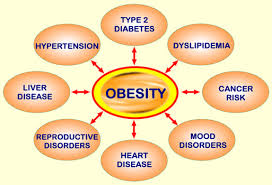What is obesity and overweight?
(Adapted from: https://www.vichealth.vic.gov.au/~/media/programsandprojects/…/obesity_fact)
Overweight and obesity is assessed by using body mass index (BMI), defined as weight in kg divided by the square of height in metres (kg/m2). A BMI over 25 is overweight; a BMI over 30 is obese.1 A normal or healthy weight is between 18.5 and 25. For example, a 165cm woman weighing 65kg has a BMI of 23.9, putting her in the healthy weight category.

What do we know?
More than 1 billion adults are overweight, with at least 300 million of them clinically obese. Global obesity levels range from below 5% in China, Japan and certain African nations to over 75% in urban Samoa. But even in countries with a relatively low prevalence, like China, rates are almost 20% in some cities. Childhood obesity is already endemic in some countries and on the rise in others. The World Health Organisation estimates that globally 17.6 million children under 5 years old are overweight. In the US, the number of overweight children has doubled since 1980 and the number of overweight adolescents has trebled. The problem extends to the developing world as well. In Thailand, the prevalence of obesity in 5–12 year olds rose from 12.2% to 15.6% in two years.
Data on the prevalence of obesity in Australian children and adolescents are not readily available. The most recent national data from 1995, estimates that 4.7% of boys and 5.5% girls aged 7-15 years were obese and a further 15.3% of boys and 16% girls were overweight but not obese.
Weight gain and obesity develops when energy intake (from food and drink) exceeds energy expenditure (from physical activity and other metabolic processes) over a prolonged period of time. Rare cases of obesity include genetic defects hormonal and drug-related problems. There are many lifestyle and environmental factors that can contribute to being overweight and obese. The rise of car ownership and the increase in driving short distances has led to less people walking or cycling. The modernisation of household appliances such as dishwashers, washing machines, microwave ovens, televisions and computers has led to a decrease in manual labour, an increase in the consumption of high fat and high sugar convenience foods, and a decrease in time spent on active leisure time activities. Even in public places, people are encouraged to use escalators and elevators rather than climb stairs.
How does excess body weight affect health?
 The link between being overweight or obese and having an increase risk of ill-health is well known. People who are overweight, especially those who are obese, have higher rates of death and illness than people of a healthy weight, both overall and from a range of specific conditions. These conditions include coronary heart disease, Type 2 diabetes, gall bladder disease, ischaemic stroke, respiratory problems, chronic musculoskeletal problems, skin problems and some cancers.
The link between being overweight or obese and having an increase risk of ill-health is well known. People who are overweight, especially those who are obese, have higher rates of death and illness than people of a healthy weight, both overall and from a range of specific conditions. These conditions include coronary heart disease, Type 2 diabetes, gall bladder disease, ischaemic stroke, respiratory problems, chronic musculoskeletal problems, skin problems and some cancers.
The likelihood of developing Type 2 diabetes and hypertension rises steeply with increasing body fatness. Approximately 85% of people with diabetes are type 2 and of these 90% are obese or overweight. This is increasingly becoming a developing world problem. If current trends continue, India and the Middle Eastern Crescent will have the highest number of diabetics by the year 2025.
Raised BMI also increases the risk of cancers of the breast, colon, prostrate, endometrium, kidney and gall bladder. Chronic overweight and obesity contribute significantly to osteoarthritis, a major cause of disability in adults. In the analyses carried out for the World Health Report 2002, approximately 58% of diabetes, 21% of ischaemic heart disease and 8–42% of certain cancers globally were attributable to a BMI above 21.1. Obese women in Australia are four times more likely to have diabetes than women of a healthy weight. Obese men and women have double the rate of high blood pressure than people of a healthy weight. Obese women are more likely than healthy weight women to have visited a hospital, day clinic or consulted a doctor in the last fortnight. Aboriginal and Torres Strait Islanders have higher rates of obesity than non-indigenous Australians. In 2001, almost one-third (31%) of Indigenous Australians were obese, compared to non-indigenous Australian rates of 16%. As well as impacting on morbidity and mortality, being overweight and obese has been shown to have a significant effect on a person’s mental and social health. Overweight or obese people may also be subject to discrimination and negative attitudes in response to their body weight. WHO states that obesity accounts for 2–6% of total health care costs in several developed countries, with some estimates putting the figure as high as 7%. The true costs are seen as greater, however, as not all obesity-related conditions are included in the calculations.
